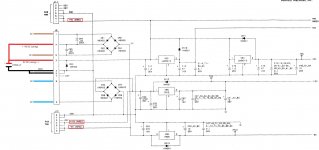bitfixer
Veteran Member
Hello,
I wanted to see if it was possible to power a PET 2001-N board directly from a bench supply instead of going through the transformer/regulators. On this machine I was using a ROMulator to replace ram, so I first removed all the RAM on the board, which as far as I could tell was the only thing which required the +12 and -5 supply - but I may be wrong about that.
Then I connected GND and +5 from the supply onto the corresponding lines on the 6502. After turning on the supply, the 5v line was only at 3.7V and the supply was drawing about 500mA, and the reset signal was also at 3.7 and did not dip to GND at any point.
First guess is that somehow the unpowered 5v regulator and associated support components create a loading effect which makes the voltage dip, but I don't really understand. Fortunately the board works fine back with the transformer, so it doesn't look like I damaged anything.
Has anyone had luck powering a PET directly from a bench supply, bypassing the regulators? Thanks.
I wanted to see if it was possible to power a PET 2001-N board directly from a bench supply instead of going through the transformer/regulators. On this machine I was using a ROMulator to replace ram, so I first removed all the RAM on the board, which as far as I could tell was the only thing which required the +12 and -5 supply - but I may be wrong about that.
Then I connected GND and +5 from the supply onto the corresponding lines on the 6502. After turning on the supply, the 5v line was only at 3.7V and the supply was drawing about 500mA, and the reset signal was also at 3.7 and did not dip to GND at any point.
First guess is that somehow the unpowered 5v regulator and associated support components create a loading effect which makes the voltage dip, but I don't really understand. Fortunately the board works fine back with the transformer, so it doesn't look like I damaged anything.
Has anyone had luck powering a PET directly from a bench supply, bypassing the regulators? Thanks.

